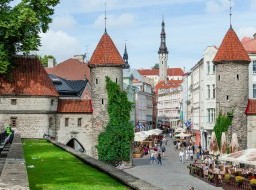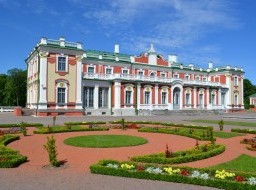Fat Margaret's Tower and Great Coastal Gate
Originally constructed in the 14th century and arguably one of the top sights in the city, Paks Margareta as she is known to locals, is 82m in diameter and boasts 5m thick walls. This museum dedicated to all sea-faring aspects of Estonia’s history is housed in one of Tallinn's fattest cannon towers. Fat Margaret Tower (Paks Margareeta) and the attached Great Coastal Gate (Suur Rannavärav), two of Tallinn's most impressive defensive structures, stand guard at the north end of Pikk street. They were built not only to defend the city from the seaward side of town, but also to impress any visitors arriving via the harbour. These days Fat Margaret’s cannon tower is home to the Estonian Maritime Museum, which provides a detailed look at the nation's seafaring past by displaying such things as Neolithic fishing gear, antique diving equipment, and even the entire wheelhouse from a 1950s-era trawler. The extensive museum covers four floors of the historic tower. From May until September, visitors can take the stairs to the rooftop for a picture-postcard view of the Tallinn harbour and Old Town while enjoying the cold treats from an ice cream café. The Great Coastal Gate, along with the Viru Gates, are the last of six gates that controlled access to the town in medieval times. The gate system here on Pikk street originated in the 1300s, but it was during reconstruction in the early 16th century that the Fat Margaret cannon tower was added. Built from 1511 to 1530, this hefty, round tower has a diameter of 25 metres, a height of about 20 metres, and walls up to 5 metres thick. The origins of Fat Margaret's name are a mystery. Some theories insist it was named for one of its larger cannons, while others hint at a cook called Margaret who once worked here. In any case, the tower has served a number of different functions throughout its history. It has been used a storehouse for gunpowder and weapons, and as a prison. This museum dedicated to all sea-faring aspects of Estonia’s history is housed in one of Tallinn's fattest cannon towers.
Fat Margaret Tower (Paks Margareeta) and the attached Great Coastal Gate (Suur Rannavärav), two of Tallinn's most impressive defensive structures, stand guard at the north end of Pikk street. They were built not only to defend the city from the seaward side of town, but also to impress any visitors arriving via the harbour.
These days Fat Margaret’s cannon tower is home to the Estonian Maritime Museum, which provides a detailed look at the nation's seafaring past by displaying such things as Neolithic fishing gear, antique diving equipment, and even the entire wheelhouse from a 1950s-era trawler. The extensive museum covers four floors of the historic tower.
From May until September, visitors can take the stairs to the rooftop for a picture-postcard view of the Tallinn harbour and Old Town while enjoying the cold treats from an ice cream café.
The Great Coastal Gate, along with the Viru Gates, are the last of six gates that controlled access to the town in medieval times. The gate system here on Pikk street originated in the 1300s, but it was during reconstruction in the early 16th century that the Fat Margaret cannon tower was added. Built from 1511 to 1530, this hefty, round tower has a diameter of 25 metres, a height of about 20 metres, and walls up to 5 metres thick.
The origins of Fat Margaret's name are a mystery. Some theories insist it was named for one of its larger cannons, while others hint at a cook called Margaret who once worked here.
In any case, the tower has served a number of different functions throughout its history. It has been used a storehouse for gunpowder and weapons, and as a prison.
This museum dedicated to all sea-faring aspects of Estonia’s history is housed in one of Tallinn's fattest cannon towers.
Fat Margaret Tower (Paks Margareeta) and the attached Great Coastal Gate (Suur Rannavärav), two of Tallinn's most impressive defensive structures, stand guard at the north end of Pikk street. They were built not only to defend the city from the seaward side of town, but also to impress any visitors arriving via the harbour.
These days Fat Margaret’s cannon tower is home to the Estonian Maritime Museum, which provides a detailed look at the nation's seafaring past by displaying such things as Neolithic fishing gear, antique diving equipment, and even the entire wheelhouse from a 1950s-era trawler. The extensive museum covers four floors of the historic tower.
From May until September, visitors can take the stairs to the rooftop for a picture-postcard view of the Tallinn harbour and Old Town while enjoying the cold treats from an ice cream café.
The Great Coastal Gate, along with the Viru Gates, are the last of six gates that controlled access to the town in medieval times. The gate system here on Pikk street originated in the 1300s, but it was during reconstruction in the early 16th century that the Fat Margaret cannon tower was added. Built from 1511 to 1530, this hefty, round tower has a diameter of 25 metres, a height of about 20 metres, and walls up to 5 metres thick.
The origins of Fat Margaret's name are a mystery. Some theories insist it was named for one of its larger cannons, while others hint at a cook called Margaret who once worked here.
In any case, the tower has served a number of different functions throughout its history. It has been used a storehouse for gunpowder and weapons, and as a prison.
|





